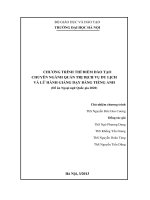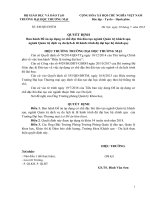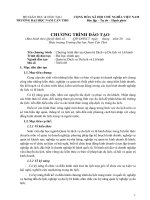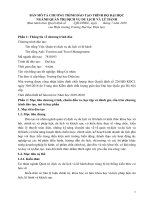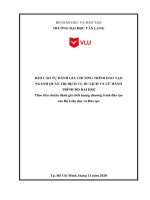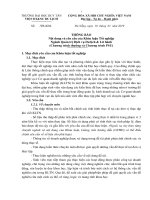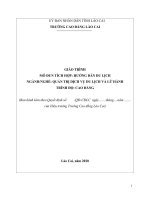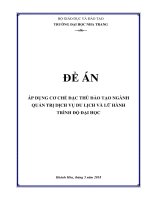Giáo trình tiếng anh chuyên ngành lữ hành hướng dẫn 2 phần 2 hướng dẫn (ngành quản trị dịch vụ du lịch và lữ hành trình độ cao đẳng)
Bạn đang xem bản rút gọn của tài liệu. Xem và tải ngay bản đầy đủ của tài liệu tại đây (8.51 MB, 279 trang )
ỦY BAN NHÂN DÂN THÀNH PHỐ HÀ NỘI
TRƯỜNG CAO ĐẲNG THƯƠNG MẠI VÀ DU LỊCH HÀ NỘI
GIÁO TRÌNH
Mơn học:
TIẾNG ANH CHUYÊN NGÀNH
LỮ HÀNH HƯỚNG DẪN 2 – PHẦN 2: HƯỚNG DẪN
Ngành:
QUẢN TRỊ DỊCH VỤ DU LỊCH VÀ LỮ HÀNH
Trình độ: CAO ĐẲNG
(Ban hành theo Quyết định số: 194/QĐ-TMDL ngày 01 tháng 8 năm 2019)
HÀ NỘI, 2020
CONTENTS
Unit 1
ARRIVALS
1. Presentation
2. Vocabulary
3. Reading
4. Language and practice
5. Listening
6. Speaking
7. Writing
8. Exercises
Unit 2
TOURIST INFORMATION
1. Presentation
2. Vocabulary
3. Reading
4. Language and practice
5. Listening
6. Speaking
7. Writing
8. Exercises
Unit 3
TOUR BOOKING
1. Presentation
2. Vocabulary
3. Reading
4. Language and practice
5. Listening
6. Speaking
7. Writing
8. Exercises
Unit 4
TOUR ITINERARY
1. Presentation
2. Vocabulary
3. Reading
4. Language and practice
5. Listening
6. Speaking
7. Writing
8. Exercises
Unit 5
DESTINATION AND TOURIST ATTRACTIONS
1. Presentation
2. Vocabulary
3. Reading
4. Language and practice
5. Listening
6. Speaking
1
2
2
4
6
7
8
9
9
16
17
17
20
21
23
24
26
27
31
32
32
35
37
38
39
41
42
49
50
50
51
56
57
59
61
68
71
71
72
73
77
80
81
i
7. Writing
8. Exercises
REVISION 1
Unit 6
TOUR COMMENTARIES
1. Presentation
2. Vocabulary
3. Reading
4. Language and practice
5. Listening
6. Speaking
7. Writing
8. Exercises
Unit 7
EATING OUT
1. Presentation
2. Vocabulary
3. Reading
4. Language and practice
5. Listening
6. Speaking
7. Writing
8. Exercises
Unit 8
RURAL TOURISM
1. Presentation
2. Vocabulary
3. Reading
4. Language and practice
5. Listening
6. Speaking
7. Writing
8. Exercises
Unit 9
ON TOUR
1. Presentation
2. Vocabulary
3. Reading
4. Language and practice
5. Listening
6. Speaking
7. Writing
8. Exercises
Unit 10
COMPLAINTS
1. Presentation
2. Vocabulary
3. Reading
4. Language and practice
5. Listening
82
85
93
102
103
103
105
108
110
110
111
113
123
123
123
125
128
137
138
140
141
146
146
146
147
150
152
152
153
155
162
162
162
164
171
173
174
180
183
188
188
188
189
192
193
ii
6. Speaking
7. Writing
8. Exercises
REVISION 2
Further Tour
Commentaries
References
193
195
204
209
221
270
iii
TUN BỐ BẢN QUYỀN
Tơi xin cam đoan cuốn giáo trình này do cá nhân tôi biên soạn, dựa trên kiến
thức chuyên môn của bản thân cùng với các tài liệu liên quan đến môn học đã được
liệt kê rõ ràng, chi tiết trong danh mục tài liệu tham khảo cuối giáo trình.
Tài liệu này thuộc loại sách giáo trình nên các nguồn thơng tin có thể được
phép dùng ngun bản hoặc trích dùng cho các mục đích về đào tạo và tham khảo.
Mọi mục đích khác mang tính lệch lạc hoặc sử dụng với mục đích kinh
doanh thiếu lành mạnh sẽ bị nghiêm cấm.
iv
LỜI GIỚI THIỆU
Hiện nay, du lịch là một trong những ngành được ưu tiên phát triển của
Việt Nam. Theo số liệu năm 2018 của Vụ Lữ hành (Tổng cục Du lịch, Bộ
VHTTDL), cả nước có gần 7000 hướng dẫn viên du lịch quốc tế, trong đó lượng
người cần tiếng Anh chiếm đến 50%, cịn lại là các ngơn ngữ khác, Như vậy,
trung bình mỗi năm Việt Nam đón trên 10 triệu lượt khách quốc tế nhập cảnh để
tham quan du lịch và kinh doanh.
Đối với các trường đại học, cao đẳng và các cơ sở đào tạo nghề, việc giảng
dạy ngoại ngữ chuyên ngành là rất cần thiết, những kiến thức này sẽ giúp sinh
viên có thể giao tiếp và vận dụng những hiểu biết chuyên ngành đã học với
khách du lịch hay đối tác nước ngoài khi tiếp xúc hoặc làm việc với họ tại các
công ty lữ hành hay tại doanh nghiệp hoặc ở bất cứ nơi nào.
Giáo trình Tiếng Anh chuyên ngành Lữ hành hướng dẫn 2 - Phần 2: Hướng
dẫn dành cho các sinh viên đã có kiến thức về Tiếng Anh chuyên ngành lữ hành
hướng dẫn 1, đã hồn thành chương trình tiếng Anh cơ bản, có khả năng nghe,
nói, đọc, viết ở trình độ trung cấp, có kiến thức cơ bản về chuyên ngành lữ hành
hướng dẫn.
Giáo trình gồm 2 phần:
Phần 1 gồm 10 bài và 2 bài ơn tập có nội dung liên quan đến các kiến thức
chuyên sâu về nghiệp vụ hướng dẫn như: đón khách, thuyết minh tại điểm, xây
dựng chương trình tour… Mỗi bài gồm 8 phần theo bố cục chặt chẽ.
Phần 2 gồm các bài thuyết minh tại điểm với các chủ đề về du lịch Việt Nam.
Giáo trình giúp cho sinh viên:
- Có kiến thức cơ bản và chuyên sâu về chuyên ngành lữ hành hướng dẫn
bằng tiếng Anh thông qua số lượng từ vựng, cấu trúc ngữ pháp, thuật ngữ
chuyên ngành.
- Có các kỹ năng, nghiệp vụ liên quan đến lĩnh vực lữ hành hướng dẫn.
- Có kiến thức về chuyên ngành lữ hành hướng dẫn, liên quan đến hoạt
động kinh doanh thông qua thực tiễn kinh doanh du lịch của các công ty lữ hành.
- Nâng cao trình độ tiếng Anh thơng qua 4 kỹ năng nghe, nói, đọc, viết
trong lĩnh vực chuyên ngành lữ hành hướng dẫn.
Trong q trình biên soạn tơi đã cố gắng lựa chọn, xây dựng nội dung sát
với kiến thức chuyên ngành, phù hợp với chương trình khung và chương trình
chi tiết của Nhà trường.
Nội dung chính để biên soạn giáo trình này:
- Dựa vào một số giáo trình Tiếng Anh về chuyên ngành lữ hành hướng
dẫn có liên quan nhiều đến các lĩnh vực trong ngành du lịch của các tác giả trong
và ngoài nước trong thời gian gần đây nhất, giúp sinh viên thực hiện được mục
tiêu giao tiếp thơng thường trong cơng việc, hồn thiện thêm kiến thức chuyên
môn nghiệp vụ bằng cách cung cấp cho sinh viên khả năng diễn đạt về ngôn ngữ
ở các kỹ năng quan trọng đối với nghề lữ hành hướng dẫn.
- Dựa vào một số hiện tượng ngữ pháp được lựa chọn kỹ để phù hợp với
mục đích củng cố kiến thức cơ bản đã học và mở rộng, nâng cao để ứng dụng
trong từng bài.
- Dựa trên các kỹ năng đọc, thuyết trình và nghe nói lấy từ các giáo trình
v
tiếng Anh với mục đích phát triển ngơn ngữ, có mở rộng về chuyên ngành lữ
hành hướng dẫn.
Trong thời gian làm giáo trình, tơi nhận được rất nhiều sự giúp đỡ, đóng
góp q báu từ phía các bạn đồng nghiệp trong khoa Ngoại ngữ, khoa Du lịch,
và Ban giám hiệu.
Tôi xin chân thành cảm ơn các khoa và sự chỉ đạo sát sao của Ban Giám
Hiệu, Phòng Đào tạo trường cao đẳng Thương mại và Du lịch Hà Nội.
Trong quá trình biên soạn khơng thể tránh khỏi những thiếu sót, kính
mong các đồng nghiệp góp ý để tơi điều chỉnh, hoàn thiện.
Xin trân trọng cảm ơn!
Chủ biên
Nguyễn Thị Hồng Hạnh
vi
UNIT 1: ARRIVALS
Objectives
After finishing the unit, students will be able to:
* Knowledge:
- Develope vocabulary related to welcoming the guest and arrival
places
* Skills:
- Greet and welcome guests
- Use structures to confirm guests‘identity
- Write an arrival information
* Attitude:
- Express confidence in communication.
- Be responsible for working
1
1. PRESENTATION
Look at the photos and answer the following questions
1.1. Where are they?
Example: at a hotel
1.2. What type of tourist or visitor is being welcomed in each case?
2. VOCABULARY
Arriving and moving on
2.1 Look at the list of arrival places. Where do you find them?
Example: at an airport, at a seaport, at a land border
1. domestic/international terminal
2. Terminus
3. Arrivals lounge
4. Customs
5. Border control
6. Immigration
7. Harbor
8. Meeting point
2.2. Match a word in A with a word in B. There may be more than one
possibility
2
A
B
1. accommodation
a. booking service
2. car
b. bus
3. city
c. centre
4. connecting
d. desk
5. information
e. flight
6. rush
f. our
7. schedules
g. lough
8. shuttle
h. rank
9. taxi
i. rental
10. transfer
j. service
11. transit
2.3. Complete the arrival information sheet using words from 2.3
If you have a__________1 flight, please go to the_________2 lounge.
There is a__________3 bus between the airport and the city centre. This
scheduled__________4 takes approximately 30 minutes (45 minutes in
the________5). Alternatively, you can go to the __________6 rank. If you have
pre-booked the transfer__________7, please go to the information__________8
to meet your driver. If you have pre-booked a hire car, please go to
the__________ __________ desks.
2.4. Insert the correct word from the box into the gaps
customs officer
check in
collection
departure lounge
immigration officer
baggage allowance
travel documents
immigration
carry-on bag
baggage
queue
visa
1. When you arrive in a country from overseas the_____ checks your passport.
In some countries you must have a_____ before you can enter. Then you
proceed to the _____ area to pick-up your bags and then to the _____ who may,
(but not always) check your baggage.
2. When you leave a country you must first _____ with the airline to get your
boarding pass. If there are a lot of people you must _____
Then you go through _____, where they check your travel documents and then
to the _____to wait for your flight.
3. On most international flights you have a _____ of 20 kilograms per person.
Many airlines allow you to take one bag on to the aircraft usually a maximum
weight of 7 kg. This is called a _____
2.5. Study the paragraph above and answer the following questions
1. What word means ‗abroad‘? __________________________________
2. What are ‗travel documents‘? __________________________________
3. What word means ‗go in‘?
__________________________________
4. What are ‗international flights‘? ________________________________
3
5. Can you name some ‗airlines‘? ________________________________
6. What word means ‗no more than‘? ______________________________
7. What is another word for ‗plane‘? ______________________________
8. What is another word for ‗depart‘? ______________________________
9. What words mean ‗for each‘? __________________________________
3. READING
Welcome - the first encounter
3.1. Match the words with their dictionary definitions
1. encounter
a. friendly and generous behavior towards guests
2. experience b. a meeting, especially one that is sudden and unexpected
3. hospitality c. a greeting that is given to somebody when they arrive,
4. welcome
especially a friendly one
d. something that has happened to you, often unusual or
exciting
1____, 2____, 3____, 4____
3.2. Read the text. Which subtitle do you think is the best?
• Tourism: the encounters industry
• Tourism: the experience industry
• Tourism: the hospitality industry
• Tourism: the welcome industry
An introduction to working in tourism
Tourism is about encounters - encounters with people, with places, and
with experiences. And the most important encounter is the first one: arrival
and greetings. Get that one right and the rest is much easier. Arrival
encounters can take place anywhere: at the airport, at the hotel, at the
campsite, in the restaurant, on the tour bus, or at the attraction. Wherever it
takes place, the rules are the same:
a Be prepared
b Look the part
c Smile
d Be interested
e Be helpful
f Be yourself
3.3. Which of the six points (a-f) would include this advice?
1. Offer to carry a bag, to get a drink, to open the door, anything to show you're
there to help.
2. Do your research - know who you're meeting, know where you're going.
3. Have confidence in your abilities and personality.
4. There are many ways of greeting in different countries, but the smile is
4
universal.
5. Dress appropriately - be smart, clean, and tidy.
6. Find out about the person you're with, and ask them about themselves.
3.4. Read the passage and answer these questions
1. What do you know about Egypt?
2. Is this a dessert or on the mainland?
3. Where is it located?
4. Why do tourists visit it and where do they
come from?
The pyramid blocks were hewn from quarries using stone and copper tools.
The blocks were transported to the pyramid site from remote quarries using
barges, and from local quarries using wooden sleds. The Egyptians did not use
the wheel during the Pyramid Age, an invention that would have been of limited
use on softer ground under heavy loads. The sleds were dragged manually,
sometimes with the help of beasts of burden, over smoothed roads. Some of the
existing pathways were equipped with transverse wooden beams to lend support
to the sled. A lubricant may have been poured upon the road to reduce friction.
Egyptians successfully completed the most massive building projects in all
of history. There is nothing magical or supernatural in the means by which they
achieved their goals, as is commonly thought. By all indications, they retained
their knowledge of construction throughout their history, but they were limited
after the Fourth Dynasty not by the lack of technology but rather by the lack of
the abundant resources that were previously available. More than two thousand
years later, the Romans would move huge stones, some weighing nearly 1,000
tons, using similar techniques at Baalbek.
Questions:
Decide if the statements below are True, False or Not Given according to
the information in the passage.
1. The wheel was invented during the Pyramid Age, even thought it was not
used.
2. Sleds were dragged by animals not humans.
3. It is possible that Ancient Egyptians could have lubricated their roads to aid
transportation.
4. The building work of the Ancient Egyptians is unrivalled.
5. Some people believed that magic may have been used by the Ancient
Egyptians.
6. Limited technology limited the construction of the Ancient Egyptians from
the Fourth Dynasty.
7. The Romans learned the techniques of moving huge stones from the Ancient
Egyptians.
5
4. LANGUAGE STUDY AND PRACTICE
* Language study
1. Welcoming
Welcome/ Welcome to Vietnam
Or welcome back to Hoi An
2. Introducing yourself
* Informal: Hi. My name‘s Joane
Oh, hi. I‘m Elex
* Formal: Good morning. My name is Hong Hanh
May I introduce myself? I‘m your guide
3. Introducing someone else
This is…
Have you met….?
4. Checking someone identity
You must be….
It‘s…, isn‘t it?
5. Making an offer
Can I/ we + get/ give/ offer, etc?
* Practice
4.1. Look at these expressions. Who says them? Write H (for host) or V (for
visitor)
1. Thank you. That‘s very kind.
2. Can I help you with your bags?
3. Do you like travelling?
4. How long does it take to get there?
5. Do you travel abroad a lot?
6. I‘m here to take you to our office.
7. No, it‘s all right, thanks. They‘re not heavy.
8. This way.
9. Did you have a good flight?
10. You can put your bags in the boot.
4.2. Look at the phrases, select the correct answer
1. Good afternoon. How ___ (is / are) it ______ (going / you)?
2. I‘ll ______ Mr. Mores know you are here. (tell/ let)
3. How was the ________ (flight / ride)? The airline staff was great.
4. _____ (do / did) you _____ (have / had) a good flight?
5. What _____ (does / was) the weather _____ (love / like)?
6. How was the ______ (train / flight) ride? It was nice.
7. ____ (Had / Have) you been to Paris before? Yes in 2008.
8. Would you like some ______ (sugar / sweet) and milk with your tea? Just
milk.
4.3. Match the questions with these answers and practice the dialog
1. Good afternoon. How is it going?
2. Did you have a good flight?
3. What was the weather like?
6
4. Have you been to Paris before?
5. How long was the train ride?
6. Maybe I can help you?
a. Very nice and sunny.
b. It was short, about 55 minutes.
c. Yes, I have an appointment with Mr. Smith.
d. No, horrible service and the plane was full.
e. Yes, three times in 2001, 2008 and 2010.
f. I‘m ok.
5. LISTENING
Greeting and introducing
5.1. Listen to eight greetings and introductions. For each one, answer the
questions.
1- Where does the conversation take place?
2- Have the speakers met before?
3- Is the conversation formal or informal?
4- Is another person or are other people introduced?
5.2. Listen again and complete the sentences
1. Hello, Peter – it‘s __________ again. Welcome to Atlanta. How was your
flight?
2. Hello, and ________ joining us tonight. ________ Praphat and __________
my colleague Amphai. We‘ll __________ on tonight‘s excursion.
3. Good __________, Mr. Ellman. Is everything to __________? __________
get you some more wine?
4. __________ introduce myself? My name is Chie Mashida and I‘m the
manager. __________ to the people who are going to be looking after you
during the conference. __________ Masako…
5. A- Hi, it‘s Johann, __________? Glad you could make it. __________?
B- Good, yeah. You?
A- __________. Have you __________ Lucy? She organized this reception.
6. Ladies and gentlemen, __________ Paradise Cruises, __________ you all on
board. We __________ to offer you a complimentary glass of champagne.
7. You __________ Ms Holweger. Welcome to Copenhagen. __________ take
your bag for you.
8. Welcome __________, Dr Allegretti. Nice __________. We‘ve put you in
your usual room.
5.3. Listen to someone picking up a car from the car hire desk at Cape Town
airport. Complete the online booking form.
Listen again. Complete the questions used by the assistant for each of the
prompts from a training guide.
1. Offer help
Can ________________________________________________ ?
2. Find out name
What _______________________________________________ ?
3. Online booking?
7
Was _______________________________________________ ?
4. Offer upgrade
Would ______________________________________________ ?
5. Check drop-off
You‘re going to drop it off in ten days‘ time?
Is __________________________________________________ ?
6. Ask age
Can you ____________________________________________ ?
7. Offer additional insurance
Do you _____________________________________________ ?
8. Check/ offer extras
Do you _____________________________________________ ?
9. Ask age of child
How old ____________________________________________ ?
10. Anything else?
Is there _____________________________________________ ?
11. Get signature
Could you ___________________________________________ ?
12. Ask method of payment
How will ____________________________________________ ?
5.4. Use the questions to practise the dialogue with a partner
6. SPEAKING
Welcoming visitors
6.1. You‟re meeting a visitor to your country at the airport
Apart from ‗welcome‘, what topics might you talk about? Choose from the list
or think of your own.
* comfortable flight?
* visited this country before?
* hungry or thirsty?
* the weather where they came from
* a brief history of your country
* what‘s going to happen in the next hour or so
* people and places in the visitor‘s country that you know
For each one you choose, what would your first sentence be?
6.2. You are at a reception for an international tourism fair in your city
Work in two groups
Group A: Meeters and greeters
You are working at the reception. Your job is to welcome each of the
guests and begin a short conversation. You may want to offer something or
introduce the guest to another person.
NOTES
Make sure that you treat each guest with the appropriate level of respect
and formality.
Two of the guests should be people that you already know.
None of the guest should be left on their own.
8
You should meet and greet as many different guests as possible.
Group B: Guests
Write your name and job/ position on a badge/ label.
Choose from this list or think of your own.
* a local hotel manager
* a local tour operator
* a local travel agent
* a tour guide
* the mayor of the city (a VIP)
* an invited guest from another country the driver who brought the mayor
When you have finished, change roles and repeat the activity
6.3. Read and practise the text
Good morning everyone. My name is Luca. On behalf of Suntan Tours, I'd
like to welcome you all to Los Cabos. The bus ride to your hotel will take about
fifteen minutes. Right now I'd like to take a minute to familiarize you with the
area and discuss some brief safety precautions. Firstly, I ask that you remain
seated until we reach our destination and that you not eat or drink while on the
bus. Secondly, please realize that it is against the law to get drunk in public.
Enjoy your vacation.
7. WRITING
Arrival information
Write an arrival information sheet for your city or region. If appropriate, include
sections on:
General arrival information
Airport to city/town centre
Intercity buses and trains
Other arrival points
Car hire
Information
------------------------------------------------------------------------------------------------------------------------------------------------------------------------------------------------------------------------------------------------------------------------------------------------------------------------------------------------------------------------------------------------------------------------------------------------------------------------------------------------------------------------------------------------------------------------------------------------------------------------------------------------------------------------------------------------------------------------------------------------------------------------------------------------8. EXERCISES
8.1. Choose the letter A, B, C or D to indicate the correct answer to each of the
following questions.
1. The man arrived at the bus stop after we _____ for him for about 2 hours.
A. had waited
B. were waiting C. waited
D. have waited
2. Tom _____ on the beach at this time next week.
A. is going to lie B. will lie
C. will be lying D. lies
9
3. I will come and see you before I _____ for Hanoi City.
A. leave
B. will leave
C. left
D. shall leave
4. He said he _____ at home.
A. is staying
B. has stayed
C. was staying
D. will stay
5. I‘m going to go out and _____.
A. have cut my hair B. have my hair cut C. cut my hair D. my hair be
cut
6. I didn‘t regret _____ a year traveling around the world.
A. spend
B. to spend
C. spending
D. to spending
7. Next month when there _____ a full moon, the ocean tides will be higher.
A. is being
B. is
C. will be
D. will have been
8. If they _____ me to their wedding party, I wouldn‘t refuse.
A. had invited
B. invited
C. invite
D. would have
invited
9. It‘s necessary for her _____ back home before 10 p.m.
A. coming
B. come
C. came
D. to come
10. They would _____ go to Ho Chi Minh City by plane than travel by train.
A. like
B. rather
C. prefer
D. better
8.2. Rewrite the sentences without changing their meanings.
1. This city is inaccessible in winter due to heavy snow.
Heavy snow makes _________________________________________.
2. It rained heavily, so we didn‘t go camping.
Had it not _________________________________________________.
3. I haven‘t been to this place before.
This is the first time _________________________________________.
4. The last time I went camping was when I was in Hue city.
I haven‘t ___________________________________________________.
5. The weather was so awful that I couldn‘t go swimming.
It was _____________________________________________________.
6. Immediately after her arrival, it rained heavily.
No sooner _________________________________________________.
7. Even though he was ill, he went to school.
Despite ____________________________________________________.
8. The man tried to escape but the police stopped him.
The police prevented _________________________________________.
9. ―Would you like to come to my party tomorrow?‖ Nam invited me.
Nam _______________________________________________________.
10. This is the last time I go to that country.
I certainly ___________________________________________________.
8.3. Choose the letter A, B, C or D to indicate the underlined part that needs
correction in each of the following questions
1. Recently, (A) the island of Hawaii (B) had been the subject of (C) intensive
research (D) on the occurrence of earthquakes.
2. We (A) will be cycled to (B) their village (C) at this time (D) next Sunday.
3. (A) Did he (B) go to the pop concert next (C) weekend for (D) a change?
10
4. (A) A tourist asked (B) how far (C) was it from Ho Chi Minh City (D) to
Hanoi.
5. We (A) are not (B) allowed to (C) cycling in the park, (D) are we?
6. She (A) was seen (B) go to the beach (C) with some (D) other people.
7. He (A) is moving to Lang Son City, (B) that is (C) in the north-east (D) of
Vietnam.
8. Maryland, (A) even though a southern state, (B) remained (C) loyalty to The
Union (D) during the Civil War.
9. Mrs. Steven, (A) along with her cousins (B) from New Mexico, (C) are
planning (D) to attend the festivities.
10. The museum (A) contains sixth century sculptures, (B) eighteenth century
swords and (C) the dress worn by nineteenth century (D) royal family.
8.4. Read the passage and answer these questions
Stonehenge Monument
Stonehenge is an ancient monument situated about ten miles north of
Salisbury in England. It was built about 4500 years ago, but by whom and for
what purpose remains a mystery. The builders must have known of geometry.
They may have been influenced by the Mycenaeans, whose architecture was
similar. Some of the stones must have been brought from West Wales, over 135
miles away. These stones weigh more than fifty tons. They may have been
brought on rafts and rollers. Experts say that it must have taken 1500 men more
than five years to transport them. Stonehenge was probably built in three stages.
First, settlers from continental Europe built a temple for sun worship. Later the
"Beaker" people added the stone circles. Finally, people of the Wesse Culture
transformed Stonehenge into an observatory. They could calculate the exact
time of Midsummer and Midwinter and of equinoxes.
Questions:
Choose the correct answer A, B, C or D
1. We understand from the passage that the construction of the Stonehenge
A) began 135 miles away from Salisbury.
B) is thought to have taken place in more than one stage.
C) was first documented by the Mycenaeans.
D) is not a mystery that needs to be solved.
E) was completed in less than five years.
11
2. It is pointed out in the reading that the Stonehenge
A) was built by the Mycenaeans, who were very advanced in geometry.
B) probably has religious origins, possibly for worship of the sun.
C) had no astrological purposes.
D) was erected thousands of years ago in West Wales.
E) is still used to calculate the changes of the seasons.
3. According to the passage, there is no certainty about
A) where the Stonehenge was built.
B) what kind of stones were used in the construction of the Stonehenge.
C) how to calculate the exact time of Midsummer and Midwinter and of
equinoxes.
D) how the stones used in the construction of the Stonehenge were
transported.
E) whether some of the stones are in position to reflect the movements of the
sun and the moon.
8.5. Read the passage and answer these questions
The Statue of Liberty
Finally, on August 5th, 1884, workers began building the Statue of
Liberty’s pedestal, or foundation, on a small island in New York Harbor.
The statue is made of a covering of pure copper, put on a ____(1) (originally
puddled iron) with the exception of the flame of the torch, which is coated in
gold leaf (originally made of copper and later altered to hold glass panes). It
____(2) stonework pedestal with a foundation in the shape of an irregular
eleven-pointed star. The statue is 151 ft (46 m) tall, ____(3) and foundation, it is
305 ft (93 m) tall.
She was a gift from the people
of France to the ____(4) 100th
anniversary
of
America’s
independence from Great Britain. She
was sculpted by Frederic Bartholdi.
Barry Moreno wrote The Statue of
Liberty Encyclopedia. He says
Frederic Bartholdi chose the place
where the statue was placed. “And
while entering the harbor by ship he
saw a small island called Bedloe’s
Island.
And he saw Manhattan, and he was ____(5) vistas, and he was aware that
New York was the pre-eminent harbor. So he selected ____(6) Statue of Liberty
for that reason. He realized his statue would have a greater impact in the busiest
harbor.”
It took more than two years to complete the pedestal and statue on the
island. The Statue of Liberty was dedicated by President Grover Cleveland on
October 28th, 1886. Millions of ____(7) immigration stations on Ellis Island 12
near Bedloe’s Island - came to see the Statue of Liberty as a symbol of their new
lives in America.
Question:
Seven parts of sentences have been removed from this article about the
Statue of Liberty. For each space in the text, write the letter of the extract
that should go there. There is one extra removed part that does not belong
to the text.
A - United States to mark the
B - is on a rectangular
C - passengers heading for the
D - New York as the site of the
E - framework of steel
F - the best location
G - but with the pedestal
H - struck by the magnificent
8.6. Practise the following conversations
Conversation 1
Guide:
It‘s about a three-minute ride up to the top of the mountain. As we
pass the two towers, the gondola may sway a little.
Tourist 1: This thing is safe, right?
Guide:
Yes, you don‘t have anything to worry about. We do about 100
trips a day up the mountain, and these tours have been going on for
over ten years without any accidents. Keep your eyes open
for wildlife as we ascend. It isn‘t uncommon to see deer and even
bears.
Tourist 2: What‘s that mountain to the left called?
Guide:
That‘s Mount Karen. And to the right of that with the three small
points is Mount Brown. Now, if you look up straight ahead, you
should be able to see a large eagle‘s nest. Does everyone see it
there?
Tourist 1: Are there any baby birds?
Guide:
That‘s a good question. I haven‘t seen any yet, but we usually see
them around this time of year.
Tourist 2: What‘s that lake down there, to the right of the green meadow?
Guide:
I‘m glad you asked. That‘s John Lake. It‘s actually a man-made
pond that was built as part of a conservation effort over twenty
years ago. During the 70‘s there was a lot of clear-cutting of forests
in the area, and much of the wildlife was lost. Since John Lake was
built, ducks, swans, and geese have returned to the area.
Tourist 1: Is this the highest mountain in this region?
Guide:
No. Actually, Mount Heather, which we will be able to see in just a
minute, has the highest peak. But, this is the highest mountain for
recreational purposes like skiing and guided tours.
Tourist 2: Can you ski throughout the year?
13
